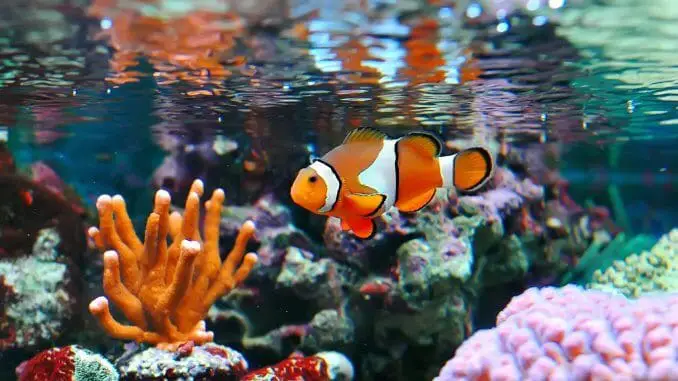
Everybody loves Nemo, so beginner fish keepers are often eager to have him swimming around their home aquarium.
Luckily, Clownfish are easy to keep and have simple diets compared to other saltwater fish.
They are also amazing to learn about, with unique communication and biology.
Each fish will bring personality in abundance, along with beautiful patterns and interesting movements, such as their ‘waddle’ while they swim.
In this article, we will talk you through how to care for them, what to feed them, and their specific tank needs.
TABLE OF CONTENTS
Clownfish Facts & Overview
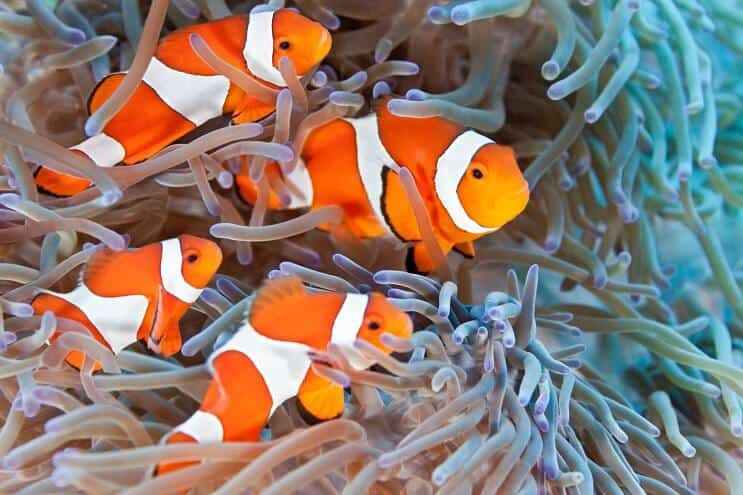
| Category | Rating |
| Care Level: | Easy |
| Temperament: | Peaceful |
| Color: | Orange, black, white |
| Lifespan: | 6 years |
| Size: | Up to 4 inches |
| Diet: | Omnivore |
| Family: | Pomacentridae |
| Minimum Tank Size: | 20 gallons |
| Tank Setup: | Marine: coral or rocks |
| Compatibility: | Community safe |
These bright little fish are many hobbyists’ first fish, making them a tried and tested beginner fish that brings personality and color to your aquarium.
There are at least thirty species of Clownfish but two of them (most frequently called Orange Clownfish) are the most popular varieties. Their care needs are very similar, so this article will focus on caring for these two species. These are the Ocellaris Clownfish (Amphiprion ocellaris, also known as the False Percula Clownfish) and the Percula Clownfish (Amphiprion percula).
All thirty species belong to the family Pomacentridae, which includes Damselfish.
They will live for 6 years however there are reports of some species living longer.
Clownfish cost around $15 and are usually available from aquatic stores that sell saltwater species as well as from online stores.
They have an interesting group structure that often fascinates aquarists, where the dominant member of the group becomes the female and forms a pair with a breeding male.
Typical Behavior
These are peaceful fish that will only turn aggressive when another Clownfish species is present – this means that a tank can only have one Clownfish species.
Living in the higher levels of the tank, they will often claim a small spot that has a weak current. They will leave this spot to be near Anemone if they are introduced, as this is where they would naturally find food.
They are well studied because of their fascinating relationship with certain species of Anemone. A combination of being resistant to the toxins and the production of mucus that prevents the Anemones from stinging them, allows them to live together.
To accommodate for their weak swimming, they need places to hide and feed.
Appearance
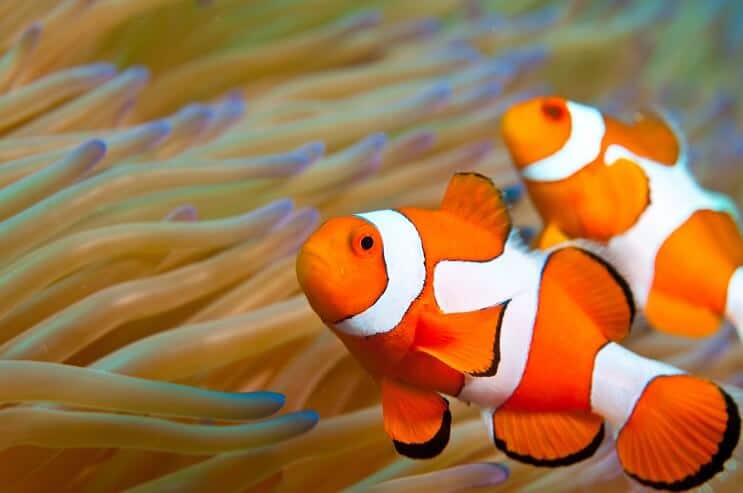
Clownfish have long bodies and a dip in their dorsal fin that makes it appear as if they have two fins and not one. The False Percula has 11 spines on their dorsal fins, compared to the True Percula which has 10 spines.
These species will grow to around 4 inches but are typically smaller. This makes them an excellent size for smaller aquariums or beginner tanks.
They have three white stripes: one behind the gills, one in the center of the body, and one at the bottom of the caudal fin. The central stripe protrudes to create a more triangular shape pointing towards the head.
Their stripes and fins often have a black outline which brings some real flare to them and makes their movements more enchanting. The False Percula will have thinner or no black outlines, which makes them bright in contrast to darker aquariums.
They have a rounded caudal fin which is why they aren’t great swimmers. It is very easy for them to be over-powered by strong filters.
True Perculas are most commonly orange, but natural black varieties can also be found. Some rare color morphs have also been bred to create varieties such as platinum (which is almost completely white).
Habitat and Tank Requirements
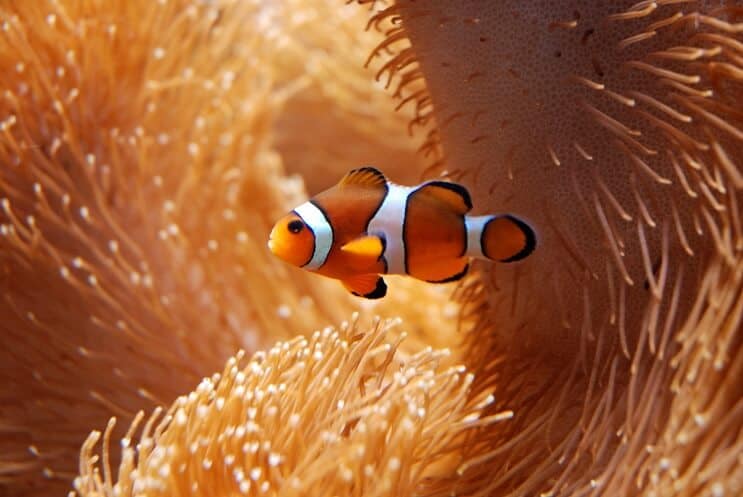
Clownfish live in the warm parts of the Pacific and Indian Ocean in coral reefs, or in shallow lagoons near Australia and Southeast Asia.
Due to their symbiosis with Anemones, they are rarely found lower than 40 foot and are not found in shallow waters due to the increased temperature and decreased salinity. They are weak swimmers, so will stick to Anemones that are protected from the current by corals or rocks.
The water near reefs has few nutrients which makes it clear. This takes time and is difficult to replicate in the home aquarium – but it is possible!
Tank Conditions
Anemones are harder to keep than Clownfish, so if you are trying to pair the two your tank must be designed around the Anemones first.
Although these fish don’t have any specific light requirements, an Anemone does so the type of lighting you need will depend on the species of Anemone you choose. Anemones will need at least a 50 gallon tank, so cannot be kept in the smaller tanks that a Clownfish can.
If this fish isn’t being kept with Anemones, then a smaller tank will work well as long as it is well established, with proper filtration and water conditions that replicate wild water conditions.
There preferred temperature is between 74-79°F, so a heater will need to be installed. A thermometer will need to be used daily to make sure that the water is kept at a constant.
The aquarium must have a pH between 7.8 and 8.4 to keep them healthy. This convenient pH also allows for pairing with many other species.
Clownfish need a specific gravity that is between 1.021 and 1.026. Fluctuations in water quality can be reduced by keeping a larger volume of water either in the tank or in a sump.
There should be a good layout for the tank which provides both aesthetic pleasure as well as practical protection for them from the water flow. This can be done using rocks or live rocks, or fake reef inserts.
The best layouts are ones that provide a combination of open swimming spaces and hiding places.
They can be kept in sediment free tanks for ease of cleaning, but some tank mates may need substrate so it is best to plan inhabitants well in advance of putting them in the tank.
What Size Aquarium Do They Need?
Clownfish need at least a 20-gallon tank, so they have enough room to both hide and explore. You will need a larger tank if you want to keep an Anemone too.
For each additional Clownfish allow a further 10 gallons.
Tank Mates
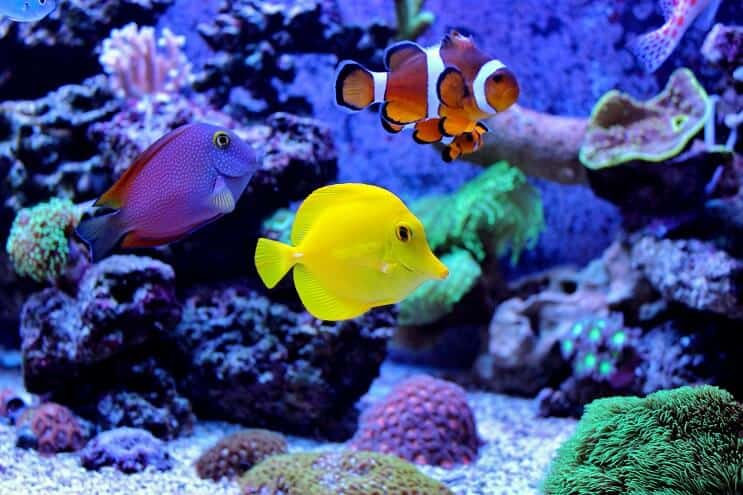
In the wild, Clownfish are found living among many other reef fish. They can live in small tanks as well as large communities, showing how adaptable they are.
It is very common to pair them with Anemones, but a pairing is not guaranteed and they can survive in captivity without this symbiotic relationship. If it is achieved however, it can be an amazing interaction to witness and to show off.
Some suitable Anemones are: Bubble Tip Anemone, Magnificent Anemone, and Leathery Sea Anemone.
Small fish such as Damselfish, Wrasses, Dartfish, and Butterflyfish are easy to keep alongside Clownfish. Bottom dwellers such as Blennies and Gobies live at different levels of the tank so are also welcome tank mates.
Shrimps (such as Peppermint Shrimps) and Harlequin Shrimps can make interesting additions, they are peaceful and helpful by breaking down waste food.
Because of Clownfish’s weak swimming, bigger fish such as saltwater Angelfish and Tangs must be monitored to make sure they are not causing stress.
Aggressive fish such as Groupers, Lionfish, Eels, and Triggerfish cannot be kept with them as they will prey on them. Also, they cannot be kept with other species of Clownfish because they will quickly become aggressive with each other.
Keeping Clownfish Together
You can keep Clownfish together – it is recommended to keep them in pairs or groups of the same species.
Diet
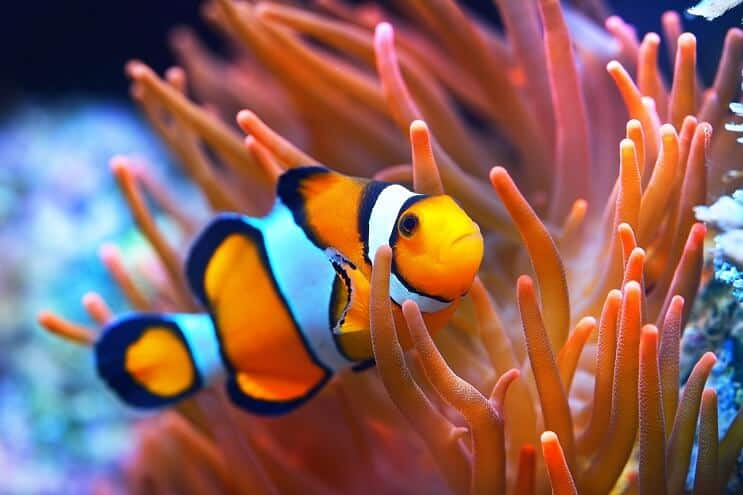
One of the things that make Clownfish such ideal beginner fish is that they are famously easy to feed.
They are omnivores that in the wild will eat copepods, small crustaceans, algae, anemone tentacles, fish eggs, and larvae.
Their varied wild diet can be replicated in the home aquarium by feeding them meaty foods such as Mysis shrimp and Brine shrimp. They will also readily eat frozen fish and table shrimp (provided it is finely chopped).
Live foods can be used to acclimate wild caught species, or to encourage breeding.
If you are lucky enough to have low algae levels in your tank, flakes and pellets that have spirulina will provide the vegetable side of their diet.
Smaller Clownfish will need to be fed near their safety zone – this will be a small area that they will almost always be in until they are larger. Once they are larger, they will still need to be fed in areas where there is not strong water flow to prevent difficulty in feeding.
Adults will need feeding twice a day, and juveniles will need feeding 3 or 4 times a day. Only give what they can eat within 3 minutes, and clean excess food out of the tank to keep the water optimal.
Care
Though they are overall very hardy and easy to care for, Clownfish can still get sick, so need regular monitoring and care. This includes regular water testing and tank cleaning.
The water parameters need to be constant. You should check water conditions often, as the quicker a change is detected, the easier it will be to put right again.
Water changes of at least 15% should be done weekly, and even more for smaller aquariums.
Excess food should be removed to prevent algal growth and nitrite/nitrate sickness. Visible algae can be cleaned using a suitable cleaner.
Clownfish can heal from most minor setbacks rapidly but are still susceptible to stronger diseases such as ick or dropsy. Research any abnormal behaviors, discolorations, or a change in appetite to take steps to help them recover.
They will care for you back by being one of the most rewarding pets to keep and reducing your stress levels too.
How To Breed Clownfish
It is possible for Percula Clownfish to be bred in captivity, but first, you must know about their biology.
Clownfish Gender Change
They are all born without a sex, and through social cues and hormone changes, they will become either a male or a female. The largest of a pair will become female, while the smaller will remain male.
If there are other Clownfish in the group, they will become males but will not breed with the female.
Breeding
Once the temperature is slightly higher, at 83°F, they will begin courtship and within 5 days they will begin spawning.
Together the breeding pair will perform rituals that include standing on their heads and pressing their dorsal fins together, alongside cleaning part of the rock near the Anemone for the eggs to be placed on.
They will produce anywhere from 50 to 500 eggs once a month, which after 8 days will hatch and swim to the surface until a fortnight later when they will find a home amongst the anemone.
Whilst they are not impossible to breed, it may take patience and a few failed attempts to get it right.
Is The Clownfish Right For Your Aquarium?
As one of the easier types of saltwater fish to look after, the Clownfish could be the start of your aquarium hobby! Or they could be your new favorite if you are considering adding it to an established tank.
They provide one of the most interesting personalities in the fish world, so are well worth considering.
If you are starting a new tank, make sure you look at a variety of species and options available so you can get the perfect tank that you are proud of.
Are you inspired to own a Clownfish? Do you have any experience with them? Let us know in the comments section below…

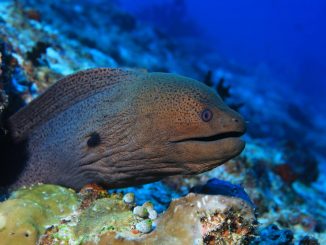
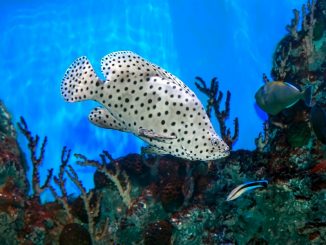
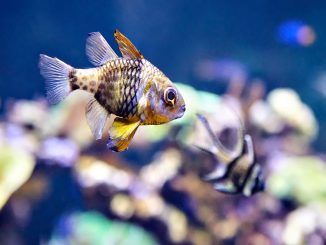
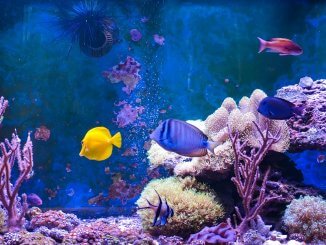
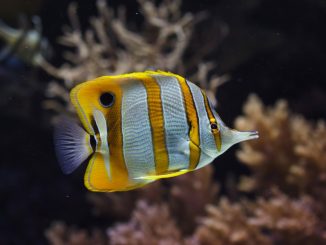
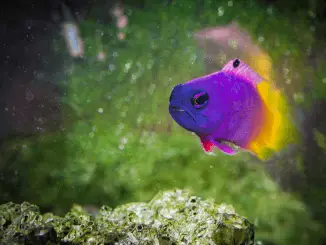
I have a Clown fish that is at least 11 years old, I am sure of that. He is like a member of our family. One of his tank mates is a Mimic Tang that has stuck him two times. He survived and healed but the seem to ignore each other the last year or two. I just wonder how much longer he will live.
Ours just passed and was 15. They can live for a long time in captivity. ☺️ We just bought a pair today. Hoping for 15 more years of happy wiggles!
My clown is just over 14 years in a 40 gallon with a large tomato clown
Lemon damsel striped damsel. And ? Blue fin damsel
Hi there
Well being a scuba diver of many years, I was keen to set up my own saltwater aquarium in the home. My wife, being a interior designer with that thought in mind, bought me a wall mounted aquarium – 9 gallons
I had planned for larger size and with clown fish and anemones as the base.
It seems anemones require a min of 50 gallons, so thats out. Some articles have said clownfish need 30 gallons, some say 20 gallons. It never says if this is for 1 pair or how many this allows to coexist ? In fact, I only ever read there is a min volume of water needed for a particular species, not the number of fish of that species? or if I add several species how many I can keep in a set volume aquarium?
I understand the reasons for limiting the number if fish in an aquarium. I also see pictures of these aquaria and it seems there are a lot of fish in them, and they don’t look like freshwater fish?
Can you clarify how this works?
Is there any info on keeping clownfish in a wall mounted aquarium?
I sense wall mounted aquaria are relatively new – is there much history in terms of ideal fish to keep and success?
Andrew